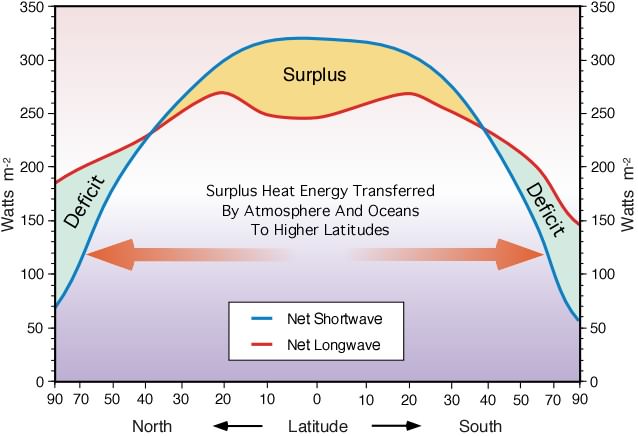INTRODUCTION TO HEAT FLUXES
Figure 7j-1 illustrates the annual values of net shortwave and net long-wave radiation from the South Pole to the North Pole. On closer examination of this graph one notes that the lines representing incoming and outgoing radiation do not have the same values. From 0 - 35 ° latitude North and South incoming solar radiation exceeds outgoing terrestrial radiation and a surplus of energy exists. The reverse holds true from 35 - 90° latitude North and South and these regions have a deficit of energy. Surplus energy at low latitudes and a deficit at high latitudes results in energy transfer from the equator to the poles. It is this meridional transport of energy that causes atmospheric and oceanic circulation. If there were no energy transfer the poles would be 25° Celsius cooler, and the equator 14° Celsius warmer!
Figure 7j-1: Balance between average net shortwave and long-wave radiation from 90° North to 90° South.
The redistribution of energy across the Earth's surface is accomplished primarily through three processes: sensible heat flux, latent heat flux, and surface heat flux into oceans. Sensible heat flux is the process where heat energy is transferred from the Earth's surface to the atmosphere by conduction and convection. This energy is then moved from the tropics to the poles by advection, creating atmospheric circulation. As a result, atmospheric circulation moves warm tropical air to the polar regions and cold air from the poles to the equator. Latent heat flux moves energy globally when solid and liquid water is converted into vapor.
This vapor is often moved by atmospheric circulation vertically and horizontally to cooler locations where it is condensed as rain or is deposited as snow releasing the heat energy stored within it. Finally, large quantities of radiation energy are transferred into the Earth's tropical oceans. The energy enters these water bodies at the surface when absorbed radiation is converted into heat energy. The warmed surface water is then transferred downward into the water column by conduction and convection. Horizontal transfer of this heat energy from the equator to the poles is accomplished by ocean currents.
The following equation describes the partitioning of heat energy at the Earth's surface:
Q* = H (Sensible heat) + L (Latent heat) + S (Surface heat flux into soil or water)
The actual amount of net radiation being partitioned into each one of these components is a function of the following factors:
- Presence or absence of water in liquid and solid forms at the surface.
- Specific heat of the surface receiving the net radiation.
- Convective and conductive characteristics of the receiving surface.
- Diffusion characteristics of the surface's overlying atmosphere.
CITATION
|
Pidwirny, M. (2006). "Global Heat Balance: Introduction to Heat Fluxes". Fundamentals of Physical Geography, 2nd Edition. 5/1/2012. http://www.physicalgeography.net/fundamentals/7j.html
Do you like this post? Please link back to this article by copying one of the codes below.
URL:
HTML link code:
BB (forum) link code:


